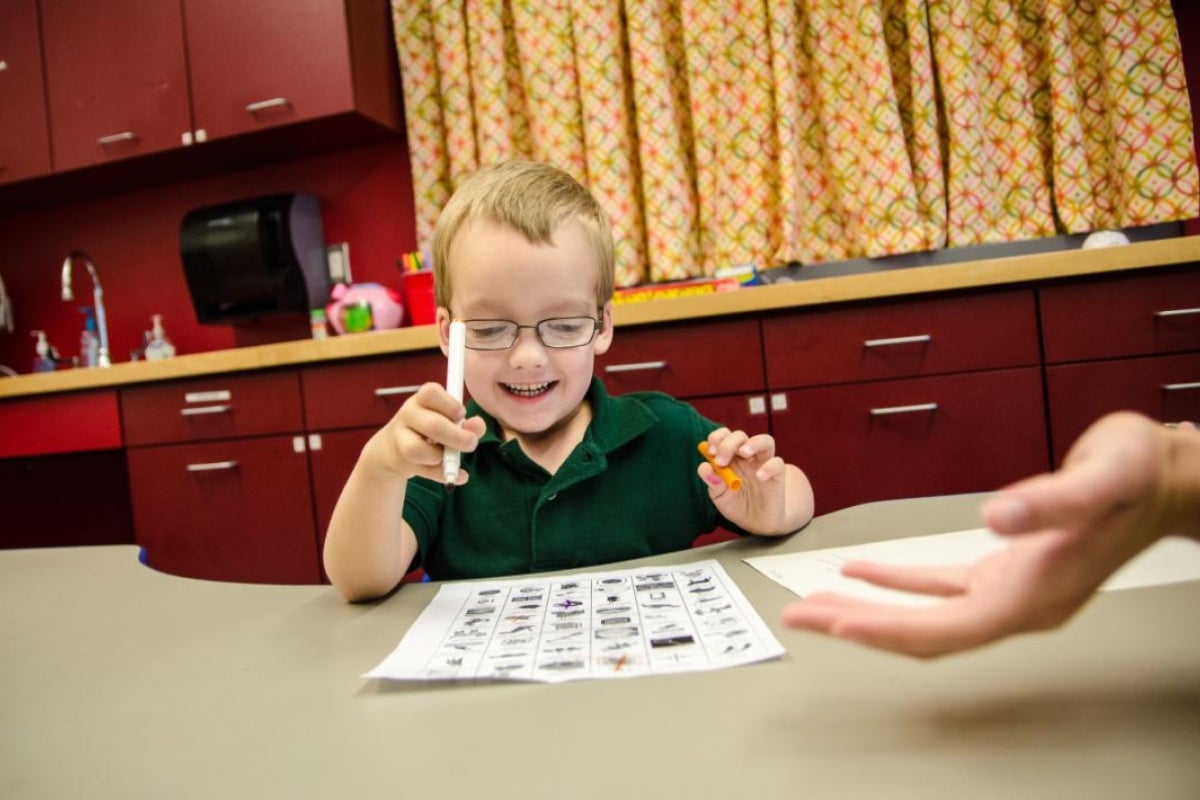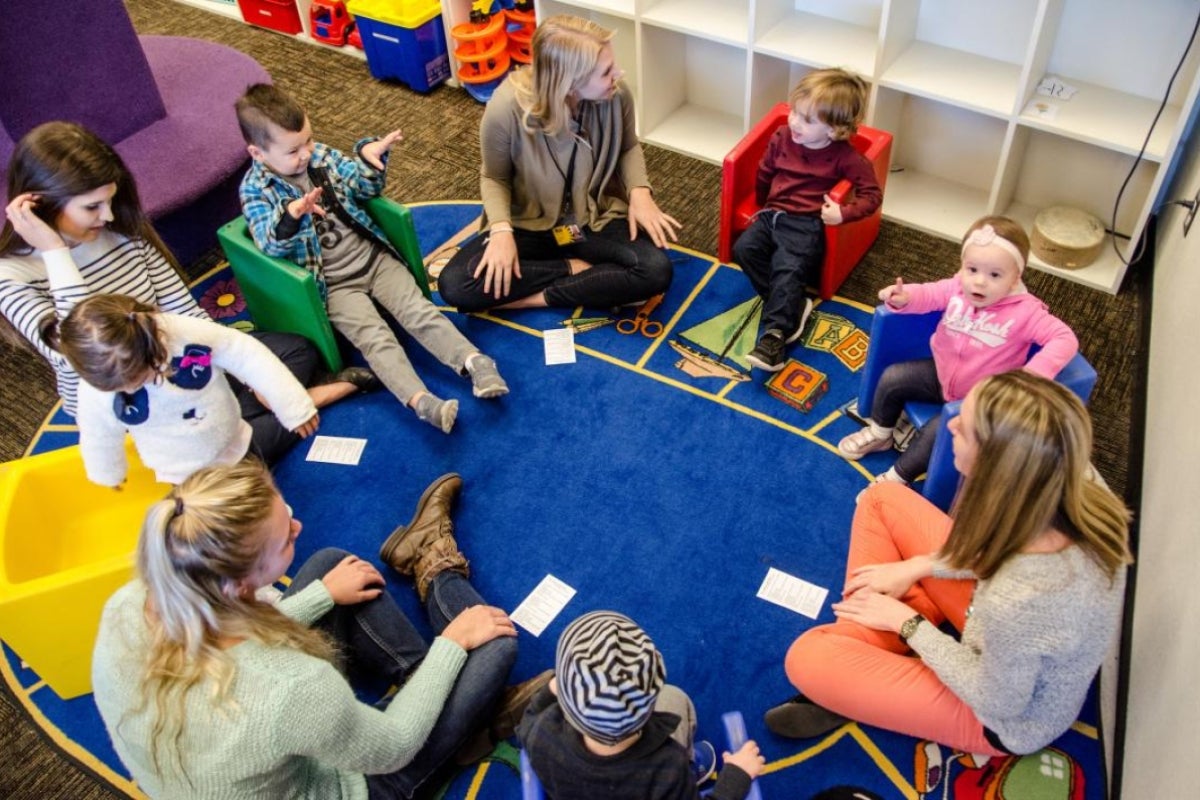A group of toddlers sits in a circle, singing and passing around maroon and gold pom poms. When the they come around to a shy 2-year-old, everyone sings, “Who are we rooting for?”
He shouts, “Max!” and beams a wide smile as they cheer.
The enthusiasm is in contrast to when he began coming to these sessions a few months ago. Back then, Max’s mother, Kelly Whalen, said she had to sit with him until he worked up the nerve to join the rest of the bunch.
Part of Max’s problem socializing, Whalen said, was difficulty speaking, and the twice weekly song time is part of an ASU program involving grad students who give youngsters one-on-one attention to help them work through speech problems.
"Early intervention is key to giving children with speech language delays the best chance to become effective communicators," said Pediatric Communications Clinics (PCC) director and clinical supervisor Dawn Greer. "The earlier children are identified and receive services, the better."
The PCC at ASU provides speech therapy for toddlers and preschoolers through the university’s Department of Speech and Hearing Science. Most recently, it was joined by the After School Articulation and Phonology Program, which in the fall began offering similar services for kids from kindergarten through fifth grade.
"The PCC is a great resource for young children with speech sound disorders, but we wanted to reach families with older children as well, so we developed” the program, which goes by ASAP, said Kelly Ingram, whose ASU Speech and Language Clinic administers both ASAP and PCC.
Each program was designed to fill a void: PCC focuses on early intervention to facilitate children’s communication, language, articulation, motor and social skills — before they begin traditional schooling. ASAP, meanwhile, steps in to bolster in-school speech therapy.
Ingram explained that while in-school speech therapy is a good start, there can be downsides: Children are often pulled out of regular classes and end up missing lessons; The caseloads of in-school speech therapists are often very large, which means kids aren’t getting a lot of individual attention; And the criteria for a child to qualify for speech therapy is based on age, meaning in some cases, children aren’t receiving therapy until the problem has worsened.
“Even if they’re only here for an hour and 15 minutes every week, they’re still getting a lot of practice,” ASAP clinical faculty supervisor Cathy Bacon said. “Probably more than they’re getting all week long in the schools. ASAP provides intense, individualized instruction at a low cost.”
PCC and ASAP also give graduate students in the speech-language pathology master’s program and undergraduate students working toward a speech language pathology assistant certificate hands-on experience under direct supervision of Department of Speech and Hearing Science clinical faculty.
The child participants attend once or twice weekly sessions, depending on need, on a semester-by-semester basis. The sessions range from an hour and 15 minutes to two hours, during which time the children are guided by the ASU graduate and undergraduate students through a series of activities and one-on-one drills.
The type and intensity of the activities vary based on the age group but can include singing, musical instruments, art projects, sensory play, story time, snack and outdoor play. All of the lessons are planned by the ASU students, who also set up individualized road maps for each child that detail specific areas that need work, identify goals and provide weekly progress reports for parents.
“There’s no other way to get this kind of hands-on experience,” said Sarah Shill, a speech and hearing science undergrad with ASAP. She and fellow speech-language pathology students Jessi Johnson, Dominique Vasquez and Andrea Valentin make up the program’s first cohort.
“They work so well together, troubleshooting child behavior during sessions and collaborating on lesson plans,” clinical faculty supervisor Kate Helms Tillery said.
She and Bacon observe each session in an adjacent room where they can see and hear everything that goes on, taking note of what needs work and what’s working well, so they can give the ASU students notes and guidance afterward.
“We have amazing feedback from the professors basically every day,” Valentin said.
Greer also closely observes each PCC session and provides feedback.
The programs are growing. The Department of Speech and Hearing Science is next looking at making their existing summer reading program available during the regular school year.
According to Bacon, these type of outreach programs are “just another way ASU is reaching out to provide services to the community while providing quality training opportunities for students.”
Organizers say the individual attention is key. The ratio of ASU students to children in both PCC and ASAP is presently about 2 to 1. It varies depending on the number of participants, but is never more than one ASU student to every two children.
“You can’t beat that,” Whalen said, adding that her son Max’s progress has been “huge.”
“I wish I had known about this sooner,” she said. “It has just been the absolute perfect situation for him.”
Top photo: ASU undergraduates in the speech language pathologist assistant certificate program Dominique Vasquez (left) and Sarah Shill work with After School Articulation and Phonology child participant Marcella Morales. Photo by Anya Magnuson/ASU Now
More Health and medicine
College of Health Solutions program doing its part during Salute to Service
It wasn’t always easy for Marine veteran Chuck Hale when he first returned to civilian life. But he’ll never forget the help he received from a fellow former service member.“The first vet that helped…

What makes human culture unique?
Why is human culture — the shared body of knowledge passed down across generations — so much more powerful than animal cultures?“What’s special about our species?” is a question scientists have…

ASU honors students work on HPV research as part of Barrett College's largest-ever group thesis
Not every undergraduate student comes across the opportunity to do research as part of a team. Even fewer have had the chance to join a team of 86 students doing multidisciplinary research with real-…



